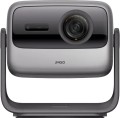Brightness ANSI Lumens
This parameter largely determines the ability of the projector to work in a well-lit room. For a dark room, 1000 lumens is enough to make the projection picture bright, rich, clear and understandable. But when working in a lit room, the projector will need at least 3500-4000 lumens. Do not confuse ANSI lumens with Peak lumens. These are two different brightness standards. To convert one type of brightness to another, you need to multiply Peak lumens by 10-12. The result will be an approximate value of ANSI Lumens.
However, experts do not recommend chasing high ANSI lumen brightness values. There are many professional projectors with brightness up to 3500 lm. The lower the brightness, the lower the power consumption, and at the same time, the life of the illuminator increases. Of course, if the projector will be installed in a work office or classroom where good lighting is required, it is recommended to purchase a model with ANSI Lumens brightness of 4000 lumens and more.
Throw distance, min
The closest distance to the screen that the projector can be used on. Typically, this is the minimum distance at which the image from the projector remains in focus.
This parameter is especially important if the device is to be placed at a small distance from the screen (for example, in a cramped room). Some modern projectors are able to work normally at a distance of 10 – 20 cm. Also note that the throw distances are determined primarily by the lens, and if the initial range of these distances does not suit you, perhaps the situation can be solved by replacing the optics.
Image size
Size of the image projected by the projector. Usually, it is indicated as a range — from the smallest, at the minimum throw distance, to the largest, at the maximum. About throw distances, see above; here it is worth saying that the choice of diagonal size depends both on the distance between the screen and the audience, and on the format of the projector. For example, to watch a video, the best option is the situation when the distance from the viewer to the image corresponds to 3-4 diagonals, and a relatively large picture can be useful for working with presentations. More detailed recommendations for different situations can be found in special sources; here we only recall that the image must fit on the screen used with the projector.
Features
—
Light sensor. A sensor that detects the level of ambient light. Most commonly used to automatically adjust the brightness of the projector to suit current conditions. So, in a darkened room, high brightness is not needed, but in daylight, on the contrary, you cannot do without it. You can also adjust the operating mode manually, but it is more convenient when the projector does it automatically.
—
DLNA support. DLNA technology is designed to connect home electronics into a single network and exchange content in real time. One of its advantages is that DLNA devices are guaranteed to be compatible with each other regardless of model and manufacturer. In a projector, this feature can be used, for example, to view a movie on a large screen from a computer hard drive, or to display an Internet broadcast on this screen that was originally opened on a tablet. DLNA works on the basis of a standard local network, with a connection via LAN (see "Management ports") or Wi-Fi (see below).
—
MHL support. The projector has
HDMI inputs that support the MHL standard. This standard is used to transfer video and audio from mobile gadgets (via microUSB) to external devices. Accordingly, this feature is useful for those who plan to connect smartphones and other portable equipment to the projector. At the same time, an MHL gadget connected t
...o a compatible HDMI port can also be charged in the process. Note that you can also output the MHL signal to a regular HDMI port, but this will require an adapter, and the charging function will not be available.
— Picture-in-picture. Ability to play two channels simultaneously on one screen: main and additional (in a separate small window). The sound is played only for the main channel. This mode allows, for example, to skip a break in a football match and not be late for the second half. Note that for this function to work, images must come from different sources — for example, from two different tuners, or from a tuner and an external device (DVD player, media centre, etc.).
— PJ-Link protocol. The projector supports the PJ-Link protocol. This is a service standard designed to control projectors over local networks (usually LAN or HDBaseT, see "Management port"). All PJ-Link-enabled equipment (projectors, controllers) is fully interoperable regardless of brand and manufacturer, making it much easier to build networks of multiple projectors and replace individual components in such networks.
— 3D support. Support for 3D implies the ability to reproduce three-dimensional stereoscopic images. A 3D image can be based on various technologies. Traditionally, active (see the relevant paragraph), passive (see the relevant paragraph) and hybrid 3D technologies are distinguished. Special glasses are required to view the three-dimensional image. In the case of active 3D, special shutters are built into the glasses, which operate from an independent power source. For passive and hybrid 3D, regular 3D glasses without battery power are sufficient.
— Active 3D. Active 3D technology is based on the principle of alternating flickering of the image. The flickering of the image on the screen is synchronized with the flickering of the lenses in the glasses, as a result, each eye receives a separate image, which makes the picture three-dimensional. The main advantage of active 3D is the ability to view images without reducing the original picture quality. You can look at the screen from any angle and from any position, while the image will still be three-dimensional. Among the shortcomings, there is the presence of some discomfort for the eyes, which occurs due to the regular flickering of lenses in glasses. Also, active 3D glasses may darken the original brightness of the image somewhat. Additionally, glasses of this type are very expensive.
— Passive 3D. Passive 3D provides the display of a double image. Passive 3D glasses use special lenses that cut off the duplicate image in such a way that each eye sees only the image intended for it, which creates the illusion of a three-dimensional image. The main advantage of passive 3D is that it does not tyre the eyes, which is typical for active flickering 3D. Passive 3D glasses are inexpensive.
— Interactive pen. The projector supports interactive pen technology. This technology allows you to actually turn the projected image into an interactive whiteboard: with a pen, you can draw, write and make notes directly on the projected image, which is especially useful during presentations and educational events. It is worth taking into account that the pens themselves and additional equipment for their work may not be included in the set.
— Multimedia (air mouse remote). Air mouse remote are devices that have a gyroscope, which allows you not only to switch menu items with the “↑”, “↓” buttons, but to use the remote control as a mouse. By directing it to the screen, a cursor will appear that moves in the direction of the remote control. This makes management easier and faster.
— Voice control. The projector's support for voice control allows you to dictate certain commands through the remote control. However, voice control does not cover all functions and recognition accuracy may require re-entering the command. If you need a more extensive range of functions, then pay attention to the voice assistant.
— Voice assistant. For a long time now, device control has been shifting to voice commands. For this, certain interfaces and systems are used. The most popular are Amazon Alexa and Google Assistant. For "apple" devices, this is Apple Siri, but this technique is not presented in projectors. At the same time, unlike the voice control function, the voice assistant does not just turn on this or that function, mode, makes it louder, quieter, but allows you to perform certain operations in applications, whether it is to launch the desired clip on Youtube or display the weather in the browser.
